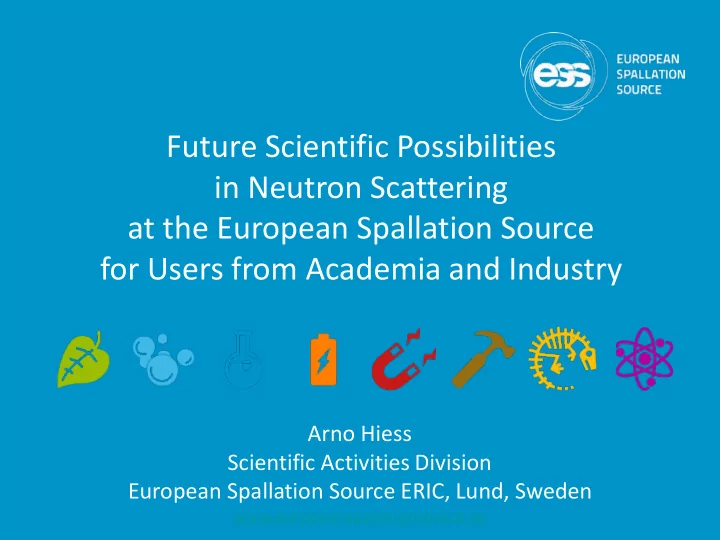

Future Scientific Possibilities in Neutron Scattering at the European Spallation Source for Users from Academia and Industry Arno Hiess Scientific Activities Division European Spallation Source ERIC, Lund, Sweden www.europeanspallationsource.se
European Spallation Source - Scope Neutron Methods “ A partnership of European Nations collectively building Science, User and operating the world ’ s Research Access leading user facility for research using neutrons . ” idea proposal , experiment, data, publication by user sample, labs sample env. modeling by user
The European Spallation Source ERIC Project Commitments 5 MW accelerator capability, 2.8ms long pulse, 14Hz Innovative instrument suite with initially 16 instruments Construction cost of 1,843 B € ; Steady-State Ops at 140 M € /year
The road to realizing the world’s leading facility for research using neutrons 2025 ESS construction complete 2014 Construction work starts on the site 2023 ESS starts 2009 user program Decision: ESS will be built in Lund 2019 First neutrons on instruments 2012 ESS Design Update phase complete 2003 First European design effort of ESS completed
Construction ongoing July 2014 Dec 2014 Dec 2015
Evolution of neutron sources
The unique ESS long pulse of cold neutrons (E = 2.5meV) x10 13 15 ESS 5 MW 2015 design Brightness (n/cm 2 /s/sr/ Å ) Possibilities of pulse shaping λ = 5 Å 10 ESS 5 MW 2013 design (TDR) 5 JPARC 0.3-1 MW SNS 1-2 MW ISIS TS2 ISIS TS1 32 kW ILL 57 MW 128 kW 7 0 time (ms) 1 2 3 4 more cold neutrons per second than any steady state source … … with higher brightness than any other spallation source
The ESS Neutron Instrument Suite NMX BEER C-SPEC BIFROST MIRACLES MAGIC T-REX ODIN HEIMDAL DREAM VOR 15 (+1) Neutron LoKI Instruments (2025) SKADI FREIA HR-NSE VESPA ESTIA Proton beam 150 m 50 m 100 m Instrument Layout (Jan 2016)
Science Drivers for the Reference Instrument Suite Multi-Purpose Imaging Cold Direct Geometry Large-Scale Structures ODIN Spectrometer C-SPEC General-Purpose SANS Wide Bandwidth Direct SKADI Geom. Spectrometer VOR Spectroscopy Broadband SANS Bispectral Direct Geometry LOKI Spectrometer TREX Surface Scattering Cold Crystal-Analyser Spectrometer CAMEA Horizontal Reflectometer Vibrational Spectrometer FREIA VESPA Vertical Reflectometer Backscattering ESTIA Spectrometer MIRACLES Thermal Powder High-Resolution Spin-Echo Diffractometer HEIMDAL Bispectral Powder Wide-Angle Spin-Echo Diffractometer DREAM Diffraction Fundamental & Particle Monochromatic Powder Physics Diffractometer Materials Science Diffractometer BEER Outside ESS construction scope: life sciences magnetism & superconductivity • Fast neutron application (BNCT, chipIR) Extreme Conditions Diffractometer soft condensed matter engineering & geo-sciences • neutron- antineutron oscilaations Single-Crystal Magnetism • Isotope production, material irradiation chemistry of materials archeology & heritage Diffractometer MAGICS conservation • µSR, neutrinos Macromolecular energy research fundamental & particle Diffractometer NMX physics
‘ ’ Partner Day Belgium Neutrons are special February 2014 charge neutral: deeply pene-trating • • ... except for some isotopes nuclear interaction: cross section • 6000 ba depending on isotope (not Z), − − − sensitive to light elements. Å Å Å spin S = 1/2 : probing magnetism • unstable n → p + e + ν e with life • − c time τ ~ 900s , I = I 0 e - t/ τ − − b a mass : n ~p; thermal energies • − − − − − − − − − result in non-relativistic velocities. µ E = 293 K = 25 meV, é – µ µ v = 2196 m/s , λ = 1.8 Å µ µ µ WHERE ARE THE ATOMS AND WHAT DO THEY DO? 10 “up”, “up”, “down”. “up”, “down”. “down”. í í í í í í
Scattering based on Momentum and Energy conservation
Length and Energy Scales ↵ ↵ fi “Hot ” ↵ ↵ ↵ ↵ fi ↵ –
User Community based on publications other Russia NL+BE SE+DK PL+CZ+A T North France America ES Australia CH Germany Europe IT United Asia Kingdom European Community 5000 - 6000 researchers 2000 publications per year 13 data: ESFRI, KFN
Neutron use per science topic theory applied + instrumental nuclear structure + physics chemistry Life Science materials soft matter magnetism 14 Liquids + glasses data: ILL
Formation of nano-MOF-5 in the presence of a modulator environment, energy Metal organic frameworks (MOF): hybrid materials with organic and inorganic components Large internal surfaces: promising candidates for gas storage, gas separation and catalysis. Contrast matching using (partly) deuterated compounds reveals shell around the MOF The modulator wraps around nanoparticle. Zacher et al. (ILL 2014)
Neutrons for Energy Research energy Real-time neutron diffraction studies of electrode materials for Li-ion batteries. Neutrons are sensitive to light elements light lithium. High intensity powder diffraction reveals lithium extraction / insertion in electrode material. Bianchini and Suard (ILL 2014)
Stress around fatigue cracks new materials, mobility Fatigue + Creep Crack in 25mm Austenitic steel 10 1600 1400 8 Distance from ligament / mm 1200 1000 6 800.0 600.0 4 400.0 200.0 2 0 -200.0 0 -400.0 -600.0 -2 Exploring the boundaries of spatial -4 22 / 1e-6 resolution achievable in real materials -6 engineering components. 0 2 4 6 8 10 12 14 Distance from pre-crack tip / mm Using combinations of in-situ techniques: imaging & diffraction, in- situ loading, high- temperature… A Steuwer et al, J Appl Crysts (2004)
Neutron use per science topic theory applied + instrumental nuclear structure + physics chemistry Life Science materials soft matter magnetism 23 Liquids + glasses data: ILL
Conclusions • Neutron scattering techniques are unique and complementary to lab methods and other scattering probes. • Neutron scattering techniques have answered many questions in many science areas • … addressing the grand challenges of our society • … and the science case for neutrons is freshly written every day. • Strong European Scientific Community is mobilized and .... • … we are building ESS together now to meet our needs.
Recommend
More recommend